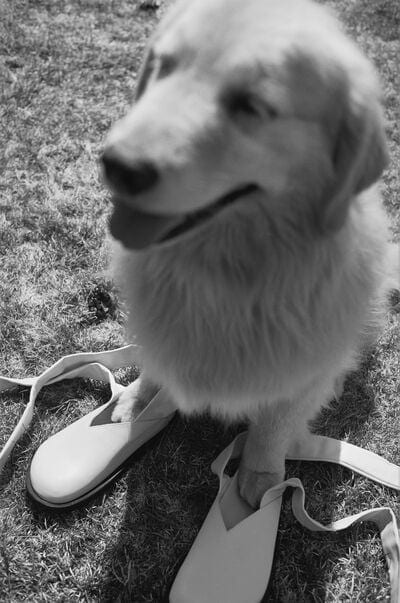




SPREADING THE WORD, ONE PAIR AT A TIME
Through distinctive branding and innovative marketing, BIRKENSTOCK developed a brand as iconic as its sandal.
FUNNY LOOKING. BUT A GREAT PERSONALITY
When Karl Birkenstock launched his Original ‘Birkenstock-Fußbett Sandale’ at the 1963 shoe trade fair in Düsseldorf, he wasn’t exactly greeted with the fanfare he anticipated. “Never before had a company been shunned the way that we were by the visitors,” he said of the event. “We were the laughingstock of the fair. We didn’t get a single order.”
Though BIRKENSTOCKS were soon embraced by medical professionals who recognised the value of orthopedic footwear, by the 1980s, they were still far from mainstream fashion staples. But rather than adapt their designs to suit the trends of the times, BIRKENSTOCK USA decided to make a feature of its product’s unique appeal. In 1984, they hired New York advertising agency, Doremus, who came up with the “Funny Looking BIRKENSTOCK Sandals” campaign—a knowing wink to their status as fad-resistant footwear.

It wasn’t the first time BIRKENSTOCK USA had used a touch of self-deprecating humor in their campaigns, nor would it be the last. A US advertisement that ran in 1979 marketed BIRKENSTOCK sandals as “a solution to the gas crunch,” with the tagline “5,000 miles to a single pair of soles!” Another ad from 1982 encouraged customers to “get into the habit!”, picturing a group of BIRKENSTOCK-wearing nuns. This kind of tongue-in-cheek sensibility helped the company to break away from the earnest associations of German orthopedics, showcasing the brand’s more playful side.
AN INSTANT ICON
BIRKENSTOCK might not have been immediately embraced on its arrival in the US—but it made an instant mark on culture. A newspaper cartoon from 1980 shows a doctor proffering a pair of sandals to a female patient, telling her: “I’m out of birth control pills—try wearing these.”

It might not have been exactly flattering, but it speaks to BIRKENSTOCK as a lightning rod for conversation, even now that the brand has been embraced.
One of the most iconic moments in Greta Gerwig’s box office-smashing Barbie film comes when the main character, played by Margot Robbie, is forced to choose between remaining in the glossy Barbie Dreamland or entering the chaos of the real world. The former is represented by a candy floss-colored stiletto while the latter is symbolized by a brown ARIZONA sandal.
What follows is a voyage of self-discovery, which ends in Barbie embracing human existence and all the complexity that comes with it. In the film’s final scene, she’s wearing rose-colored ARIZONA BIG BUCKLE sandals as a nod to her new identity. As Alexis Bennett wrote in British Vogue in July 2023: “The undeniably comfortable shoe becomes a saviour as Barbie endures her new flatfooted existence.”
BIRKENSTOCKS’ feature in the film was a decision made organically by director Greta Gerwig for which no money exchanged hands. But the result was an unforeseen boost in sales, with the ARIZONA model worn by Barbie quickly selling out.
A strong look
The BIRKENSTOCK brand has always had a close relationship with design, and the importance of an ownable visual language in communicating its philosophy around health-focused footwear can be felt in everything from product to promotional material. In fact, Carl Birkenstock embodied the mid-century design ethos of “form follows function” in his footbeds generations before Walter Gropius articulated the Bauhaus movement’s founding principles.

Later, BIRKENSTOCK recognized the value of engaging retailers and customers in the story and ethos behind its brand, long before the time of viral marketing and email newsletters. As a means of both showcasing and explaining new products, the company began printing the BIRKENSTOCK Post in 1958, which ran for 16 editions until 1966. The pamphlets stood out for their vibrant designs, pulling inspiration from the Bauhaus movement, and contained expert endorsements from orthopedic specialists about the comfort and therapeutic benefits of the company’s footbeds.

YOU’VE GOT MAIL
The first known US catalog for BIRKENSTOCK arrived in mailboxes in 1968, trumpeting the “EXQUISIT sandal” for its “luxurious quality” and “well-tested style”. While the advertised acknowledged the more expensive price of the shoe, it reassured would-be customers that “in the long run, it pays to buy the best”.
The language and the “EXQUISIT” product line differ from what is recognisable today as the BIRKENSTOCK brand, but, like many of BIRKENSTOCK’s early catalogs, it reflects an earlier era when its now universally iconic products were tailored to suit different markets.
Up until the late 1970s, BIRKENSTOCK shoes had different names in the US and Europe. The MADRID sandal, for example, was called MAYAN in the US and Original BIRKENSTOCK-Fußbett Sandale in Germany. It wasn’t until 1979 that a unified naming system was introduced across all regions, notably because US-based importer Margot Fraser noticed consumers couldn’t pronounce the German descriptions. Each model was given a new moniker taken from a particular place around the world. Open-toed models with less coverage were named after hotter places, such as MADRID and ARIZONA, while closed-toe shoes took their names from places with colder climes, like BOSTON and ZÜRICH. All continue to be worn in all weathers – all over the world.
OUT OF THE BOX
By 2017, BIRKENSTOCK sandals had come a long way from the shelves of the orthopedic shoe shops that first stocked them. The BIRKENSTOCK Box concept was conceived as a way to celebrate this newfound high-fashion status.

Commissioned to create a transportable, ephemeral retail space that could be installed at select BIRKENSTOCK stockists as a pop-up concept store, Berlin architects Pierre Jorge Gonzalez and Judith Haase created a pair of interlocking, chrome-plated freight containers with interiors that could be customized by luxury collaborators.
The first stop was in Berlin during Fashion Week, where the Box was installed outside of Andreas Murkudis’ store. BIRKENSTOCK sandals, including a custom line of ARIZONAs, were showcased on geometric cork slabs, alongside a curated range of clothing hand-picked by Murkudis.
From there, the Box travelled to New York with iconic department store Barneys and then Milan for a collaboration with 10 Corso Como before being shipped back across the Atlantic to Rick Owens’ boutique in Los Angeles in 2018. Owens designed interiors inspired by German artist Joseph Beuys, with walls lined in mirrors and felt and camel skin sculptures fabricated by his company, Owenscorp. Owens worked with BIRKENSTOCK to update the ARIZONA, MADRID and BOSTON styles in army felt (a nod to Beuys) and cow fur. These models would go on to appear on the catwalk at Owens’ SS 2019 menswear fashion show in Paris.






